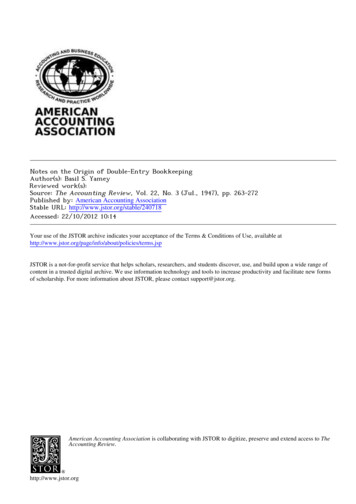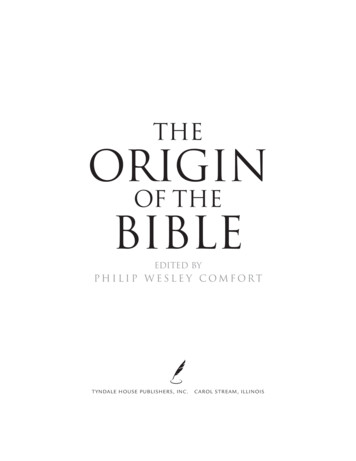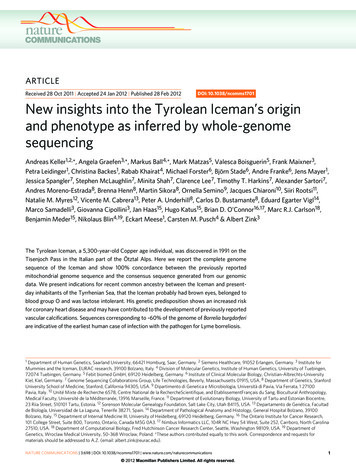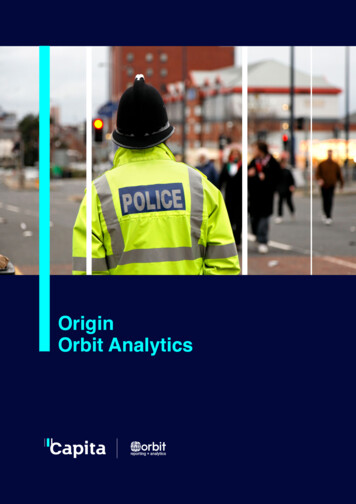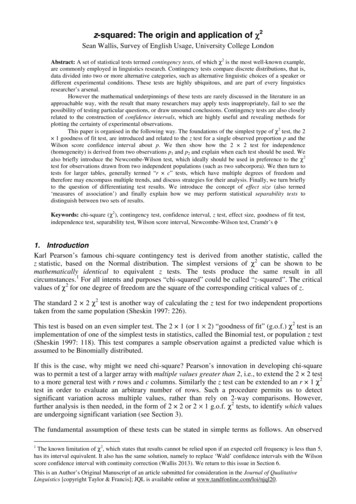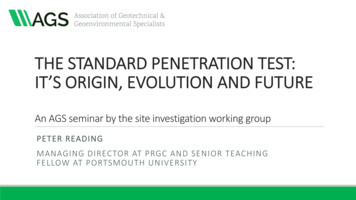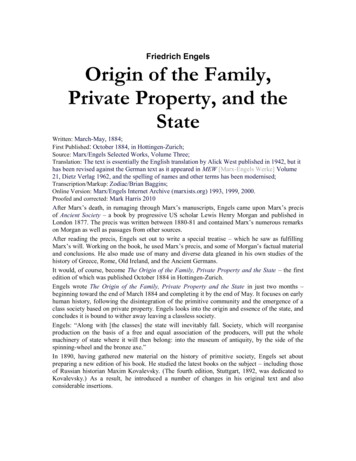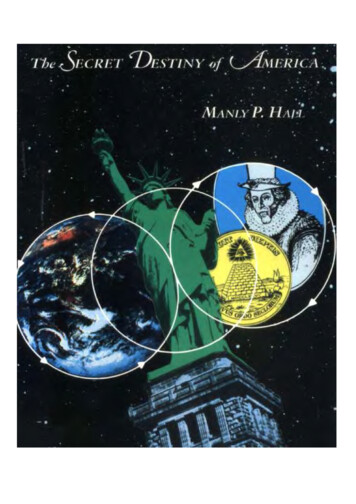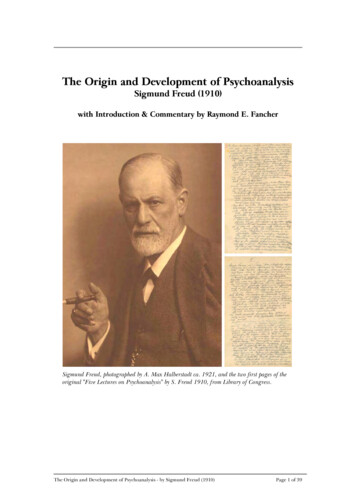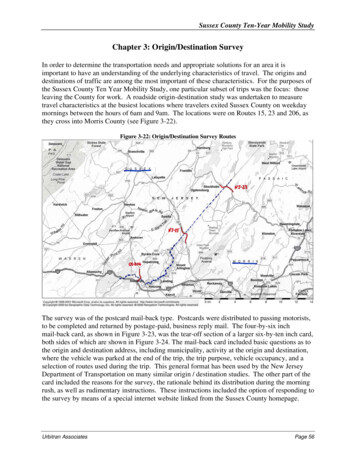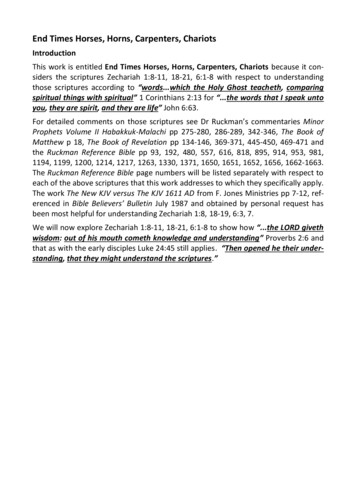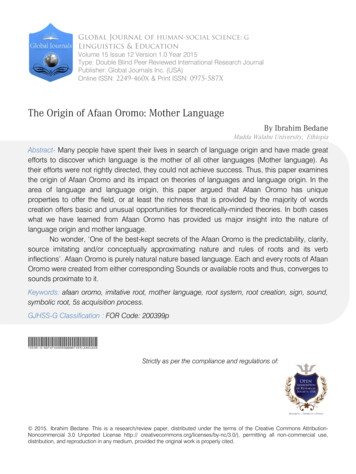
Transcription
Global Journal of HUMAN-SOCIAL SCIENCE: GLinguistics & EducationVolume 15 Issue 12 Version 1.0 Year 2015Type: Double Blind Peer Reviewed International Research JournalPublisher: Global Journals Inc. (USA)Online ISSN: 2249-460x & Print ISSN: 0975-587XThe Origin of Afaan Oromo: Mother LanguageBy Ibrahim BedaneMadda Walabu University, EthiopiaAbstract- Many people have spent their lives in search of language origin and have made greatefforts to discover which language is the mother of all other languages (Mother language). Astheir efforts were not rightly directed, they could not achieve success. Thus, this paper examinesthe origin of Afaan Oromo and its impact on theories of languages and language origin. In thearea of language and language origin, this paper argued that Afaan Oromo has uniqueproperties to offer the field, or at least the richness that is provided by the majority of wordscreation offers basic and unusual opportunities for theoretically-minded theories. In both caseswhat we have learned from Afaan Oromo has provided us major insight into the nature oflanguage origin and mother language.No wonder, ‘One of the best-kept secrets of the Afaan Oromo is the predictability, clarity,source imitating and/or conceptually approximating nature and rules of roots and its verbinflections’. Afaan Oromo is purely natural nature based language. Each and every roots of AfaanOromo were created from either corresponding Sounds or available roots and thus, converges tosounds proximate to it.Keywords: afaan oromo, imitative root, mother language, root system, root creation, sign, sound,symbolic root, 5s acquisition process.GJHSS-G Classification : FOR Code: 200399pTheOriginofAfaanOromoMotherLanguageStrictly as per the compliance and regulations of: 2015. Ibrahim Bedane. This is a research/review paper, distributed under the terms of the Creative Commons AttributionNoncommercial 3.0 Unported License http:// creativecommons.org/licenses/by-nc/3.0/), permitting all non-commercial use,distribution, and reproduction in any medium, provided the original work is properly cited.
The Origin of Afaan Oromo: Mother LanguageOI.Introductionur world has over five thousand languages thatare spoken in 2004 (Dalby 2004). Everylanguage is unique and uniquely important wayto make sense of the world. Every language display, tothe practiced eye or ear, some of its own history: wordsare clearly borrowed from other languages, voiceinflections, and turn of phrase that seems to be sharedby two adjacent which shows phenomena of languageconvergence but otherwise very different languages(Yearley 2006).Author: Madda Walabu University, Ethiopia.e-mail: ibrahimbedhane@gmail.comFor centuries, people have speculated over theorigins of human language and have made great effortsto discover the mother Language (Alonso-Cortés 2007).Even some point out language of their own based ontheir personal perception and value they give to thatspecific language. Some of them laid separate claims;the Arabic, the Parsees, the Hebrew and the Aryaslanguages, have already awarded their language asmother language of mankind without clear evidence(Shah, Syed Sajid Ahmad and Zia H 2000). And also,Webb (1669) stated Chinese as the primitive languageof humankind, happily preserved by Noah and hisfamily in the ark (Christiansen 2015). As their effortswere not rightly directed, they could not achievesuccess. Thus, they failed to discover the true origin ofmother language.Around the end of the 20th century EuropeanScience Foundation was emerged as a promisingorganization to study the origin of language and oflanguages by collaborating prehistoric archaeology,genetics, cognitive sciences, neurophysiology, anthropology, linguistics, computer science and robotics(Hombert 2003). When and how did human acquirelanguage? Have all languages developed from a singlesource? What is the world’s oldest spoken language? 2015 Global Journals Inc. (US)Year51Global Journal of Human Social Science ( G ) Volume XV Issue XII Version IKeywords: afaan oromo, imitative root, mother language,root system, root creation, sign, sound, symbolic root, 5sacquisition process.Recent work by a small but increasing numberof scholars has convinced us that there is a geneticrelationship between European, Asian, and Africanlanguages. Judeo, Christian and Islam religions providean account on the mother language. The story of theTower of Babel of Judeo-Christian tradition explainedthat, there are now many languages and linguisticdiversity rather than just one as a punishment forhuman arrogance (CARSTAIRS n.d.). In noble Quran,Almighty tells us: “"O’ mankind, we have created youfrom male and female and have made you into nationsand tribes, that you may know one another. Indeed themost noblest of you with Allah is the one who has themost piety." (Al-Quran Surah al-Hujuraat 49:13). Theway that people have constructed their own cultural,tribal, national, ethnic, racial identity from singleancestral family gives a clear understanding oflanguages divergence from single language. Ashumans are genetically endowed with language, then,logically, all languages are related and diverge fromsingle purely natural mother language. A languagefamily originates from a single dialect. From suchlanguage and culture that have broken up into Africa,Asiatic, and European and within them a very long timeago (Yearley 2006).-Abstract- Many people have spent their lives in search oflanguage origin and have made great efforts to discoverwhich language is the mother of all other languages (Motherlanguage). As their efforts were not rightly directed, they couldnot achieve success. Thus, this paper examines the origin ofAfaan Oromo and its impact on theories of languages andlanguage origin. In the area of language and language origin,this paper argued that Afaan Oromo has unique properties tooffer the field, or at least the richness that is provided by themajority of words creation offers basic and unusualopportunities for theoretically-minded theories. In both caseswhat we have learned from Afaan Oromo has provided usmajor insight into the nature of language origin and motherlanguage.No wonder, ‘One of the best-kept secrets of theAfaan Oromo is the predictability, clarity, source imitatingand/or conceptually approximating nature and rules of rootsand its verb inflections’. Afaan Oromo is purely natural naturebased language. Each and every roots of Afaan Oromo werecreated from either corresponding Sounds or available rootsand thus, converges to sounds proximate to it. Verbs, nounsand new roots were created from available related soundimitating roots and so and so on again and again. Thus,Oromo followed up the idea and elaborated language.According to this paper language is, not a fullydeveloped faculty in people, acquired by human gradually onday to day 5S (Sense, Sort, Set, Schematize and Speak)acquisition process. The author’s propose that it was agradual phenomenon that new roots possessed from newsound sensed and derivations were done as human thoughtprogressed. The perception of community in interpretationand creation of meaning and relationship between the rootsand sounds corresponding (sound root imitates) aloneexplains language origin. Afaan Oromo, mother language ofhuman being, has the most natural sound imitating roots.Other languages have fewer natural sound based rootsdepending on when they were derived from Afaan Oromo.2015Ibrahim Bedane
Year2015The Origin of Afaan Oromo: Mother Language-Global Journal of Human Social Science (G ) Volume XV Issue XII Version I52Which can give answer for: Where did human life firstsurface on our cosmos? Who contrived the original andprime human culture and civilization? These questionsare fascinating, and have provoked experiments anddiscussions whose history dates back at least threemillennia (Bednarik 2006). The irony is that the questhas been fruitless so far. Each generation asks thesame questions, and reaches the same impasse; theabsence of any scientific evidence relating to the mattergiven the vast distant time scale involved. To date,there was no language with clear proof of its origin. Butthere is a fair body of evidence that can be brought tobear on this subject.A best reason for studying languages is todiscover about ourselves in order to know what makesus human being. The best place to start such study iswith our mother tongue that has nurtured our minds andformed our world view (Algeo 2010). Oromo Language,referred as Afaan Oromo by its speakers and in thisarticle, is the second most widely spoken indigenouslanguage in Africa next to Hausa in Nigeria (Demie1996). It is one of a highly developed language of theCushitic languages spoken in Ethiopian, Somalia,Sudan, Tanzania, and Kenya. From forty differentCushitic linguistic and cultural groups in Africa, TheAfaan Oromo speakers are considered as one of thelargest in terms of population and their language AfaanOromo is the most extensive of the Cushitic languages(Demier 1996). When we first catch sight of it inhistorical records, it is the speech of some none-toofirst civilized 1 tribes on the earth. Of course, it had a stillearlier history, going back perhaps long before that toorigins we can only speculate 2 about. From thosemurky and undistinguished beginnings, Afaan Oromohas become the most widely spoken Cushitic languagein the world. In Oromia state, in Ethiopia, it is the officiallanguage used in courts, schools and administration(Demie 1996).The Afaan Oromo speakers, Oromos, have hada remarkable history. Bates in 1979 stated that, theOromo as an ancient race, the indigenous stock,perhaps, on which most other peoples had beengrafted (Hussein 2006). They belong to the originalfamily of Cushitic peoples lived in the central highlandsof the North-Eastern and Eastern Africa which is knownas "Ethiopia" for thousands of years. Linguistic,anthropological and historical data have linked theOromo to the so-called eastern Cushitic-speakingpeoples who have been in the Horn of Africa as far astheir history is known (Lewis 1966).1The Cushitic civilization has flourished in the Horn of Africa forthousands of years. Archaeologists have found the remains of aCushitic people, the ancestors of the Oromo, who lived along thebanks of the Nile river, possibly over seven thousand yearsago(Davidson 1991)2Cush and Cushitic genetic lines 2015 Global Journalss Inc. (US)Oromos were the source of democracy namedGada 3 , owner of Lunar based calendar (Ayyantu) 4 ,believer of a single and eternal God Waaqa. That is whyScholarly undertakings saw the Oromo as the dynamicnation. As sited in Mohammed Hassen article titled AShort History Of Oromo Colonial Experience 1870's1990's, Disinterested nineteenth century travellersamong the Oromo, D'Abbadie, were impressed byOromo’s culture and underlying unity and wrote book of'les Oromos grande nation africaine', and the greatmissionary explorer, Ludwig Krapf, suggested that'Providence has placed this nation in this part of Africafor very important reasons. It is the Germany of Africa'.Krapf,; naively and certainly ethnocentrically saw Oromoas the dynamic nation. Homer, in even more flatteringlanguage, described them as, ‘the most just of men; thefavourites of gods’ (Hassen 1999).The long, rich and fascinating history-history ofgreatness, independent existence, and stabledemocratic political culture based on the rule of law anddemocratic governance of Oromo has impacts onAfaan Oromo. Nature based self-sufficient culture ofOromo with its own unique moral principles, norms,beliefs, creeds and teachings have an influence on theways in which possible Afaan Oromo words are createdand meanings are understood. How Afaan Oromobegins and become the mother language of the world isthe subject of this paper.When I was third year University student in2008, I spoke Amharic language to my grandfather,Wako Kabato, who advised me to speak naturallanguage. He said “Afaan Uumaa fi Uumamaa hasahii,dhalatoo dhiisii” which means ‘Speak natural naturebased language not fabricated’. Then I asked him ‘how he figures out’. He replied “Afaanotaa fi Uumaa xinxalii, ni hubattaa”,literally translated, “look at nature and languages,you can understand it.’From that time on wards, I got motive to studyand understand Origin of languages so that I do know;what is language, divine gifted or acquired knowledge?How did words come to be, in the very beginning? Andwhat is the world’s oldest spoken language? Becauseof my academic background, personal nature oflanguages and linguistic considerable diversity on theorigin of language, treating these properly would be amajor undertaking. In the light of these interests and3Asmarom Legesse stated ‘the Gada-based Oromo democracy isone of those remarkable creations of the human mind that evolvedinto a full-fledged system of government, as a result of five centuriesof evolution and deliberate, rational, legislative transformation’(Legesse 2000).4Watson 2001 stated that Oromo’s indigenous calendar, Ayyantu, isbased on skillful readings of the astronomical configurations of themoon and the stars (HUSSEIN 2006)
The Origin of Afaan Oromo: Mother Language5In language, signs are what the system organizes. A sign issomething that stands for something else—for example, a word likeapple, which stands for the familiar fruit. (Algeo 2010)Table 1 : the qubee letters in international phoneticwriting �//đ//ň//p’//š//s’//ž/In this paper, my discussion will be organizedas follows. I discuss about Afaan Oromo root systemwhere I have uniquely contributed to organization ofAfaan Oromo in comparison with languages claimingorigin for all other languages. Then, I discuss creationand origin of Afaan Oromo roots at large where I haveuniquely contributed to languag
The Origin of Afaan Oromo: Mother Language. Ibrahim Bedane. Abstract- Many people have spent their lives in search of language origin and have made great efforts to discover
